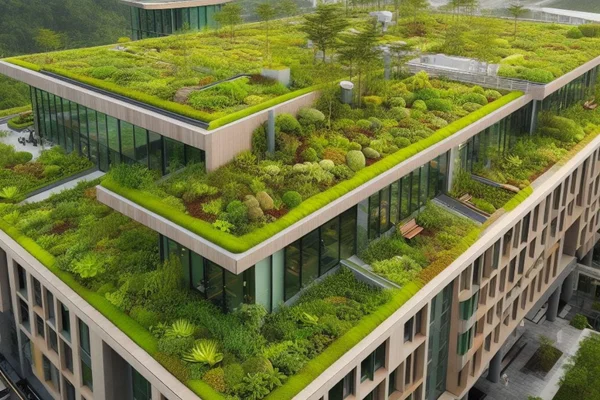Green roofs have grown increasingly popular thanks to their benefits relating to climate adaptation, mitigation, and urban biodiversity management.
About Green roofs:
- A green roof, also known as a living roof, is a roof on a building that is covered with vegetation and a growing medium, planted over a waterproofing membrane, either partially or entirely.
- Vegetation, soil, drainage layer, roof barrier and irrigation system constitute green roof.
- These planted surfaces on building rooftops absorb excess stormwater, reduce energy consumption by insulating buildings, chill neighbourhoods, moderate urban heat islands, and provide urban homes for plants, pollinators, and wildlife.
- Issue: Green roofs, often planted with non-native plants in sterile soils, may experience reduced effectiveness over time.
New study:
- A study led by Dartmouth aimed to determine if regulating the bacteria in green roof soil could enhance healthy urban soil growth.
- This approach may serve as a method to boost climate resilience in cities.
- The team established an experimental green roof in Chicago to investigate the impact of enriching soil with native prairie microbes on the soil microbial community over time.
- Their focus was on monitoring the presence of beneficial mycorrhizal fungi.
Use of Mycorrhizal fungi in Green roofs:
- Mycorrhizal fungi could be particularly helpful to plants on green roofs that have to endure high temperatures, intense sun, and periodic flooding.
- The researchers introduced soil enriched with native mycorrhizal fungi, obtained from a locally restored prairie and referred to as “inoculum,” into the soil of the experimental green roof.
- The researchers planted both inoculated and untreated soil with native prairie plants and green roof succulents.
Outcome of research:
- The finding’s results indicate that actively managing mycorrhizal fungi on green roofs leads to accelerated soil development compared to the passive reestablishment of mycorrhizal fungal communities.
- Green roofs treated with mycorrhizal fungi foster a more diverse soil community that is more likely to support long-term green roof sustainability.
Use of DNA metabarcoding:
- By employing a molecular technique called “DNA metabarcoding,” which allows the identification of multiple organisms in a single sample, the researchers were able to identify fungi in the green roof soils and potential sources of these fungi.
- Many fungi came from the inoculum while other species got there through some other vector such as wind.
About Mycorrhizal fungi:
- Mycorrhizal fungi are well-known to live in roots and support plants in a symbiotic underground relationship, delivering nutrients and water to them in exchange for plant sugars.
- This mutually beneficial relationship is known as mycorrhiza, and it is crucial for the growth and health of many plants.
- The word “mycorrhiza” comes from the Greek words “myco,” meaning fungus, and “rhiza,” meaning root.
- In this symbiotic association, the mycorrhizal fungi colonize the plant roots, forming a network of hyphae (thread-like structures) that extend into the soil.
- The fungi colonize the roots of the plant, both extracellularly and intracellularly.
- This network significantly increases the surface area for nutrient absorption by the plant roots.
- In return, the plant provides the fungi with carbohydrates produced through photosynthesis.
Type:
- Mycorrhizae come in seven types: Endo (arbuscular), Ecto, Ectendo, Arbutoid, Monotropoid, Ericoid, Orchidaceous.
- Endomycorrhizae and ectomycorrhizae are the most common and widespread types.
- Ectomycorrhizal (ECM): In ECM associations, the fungal hyphae form a dense sheath around the plant root and may also penetrate between the root cells.
- This type is commonly found in trees, such as pines, oaks, and birches.
- Arbuscular Mycorrhizal (AM): In AM associations, the fungal hyphae penetrate the plant root cells, forming structures called arbuscules.
- This type of mycorrhiza is more common in a wide range of plants, including many crops, grasses, and flowering plants.
Ref: Source
| UPSC IAS Preparation Resources | |
| Current Affairs Analysis | Topperspedia |
| GS Shots | Simply Explained |
| Daily Flash Cards | Daily Quiz |
Frequently Asked Questions (FAQs):
What constitutes a green roof?
A green roof, also known as a living roof, consists of vegetation, soil, a drainage layer, a roof barrier, and an irrigation system, all planted over a waterproofing membrane.
What benefits do green roofs provide?
Green roofs absorb excess stormwater, reduce energy consumption by insulating buildings, chill neighborhoods, moderate urban heat islands, and provide urban homes for plants, pollinators, and wildlife.
How can mycorrhizal fungi enhance the effectiveness of green roofs?
Mycorrhizal fungi help plants on green roofs endure high temperatures, intense sun, and periodic flooding by forming a symbiotic relationship with plant roots, delivering nutrients and water in exchange for plant sugars.
What is DNA metabarcoding and its use in the study of green roofs?
DNA metabarcoding is a molecular technique that allows the identification of multiple organisms in a single sample. It was used to identify fungi in green roof soils and potential sources of these fungi in the study.



